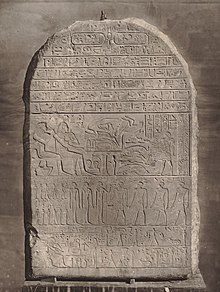Our website is made possible by displaying online advertisements to our visitors.
Please consider supporting us by disabling your ad blocker.
Itjtawy
 | |
| Location | Faiyum Governorate, Egypt |
|---|---|
| Coordinates | 29°34′13″N 31°13′52″E / 29.57028°N 31.23111°E |
Itjtawy or It-Towy[2] ("Seizer of the Two Lands"), also known by its full name Amenemhat-itjtawy ("Amenemhat seizes the Two Lands"), was an ancient Egyptian royal city established by pharaoh Amenemhat I.[3]: 266
As yet, Itjtawy’s exact location remains unidentified. Circumstantial evidence suggests that the site lies beneath cultivated fields east of the pyramids of Amenemhat I and Senusret I at Lisht.[3]: 266
There is evidence that Amenemhat, the founder of the 12th Dynasty who ruled approximately 1991 to 1962 BC, established Itjtawy during his regnal year 20, replacing Thebes as the capital of Egypt.[1] However, the earliest known mention of Itjtawy is dated to the pharaoh’s regnal year 30 (ten years later its presumed foundation), and is represented by the double-dated stela CG 20516 now in Cairo Museum.[1][2]
Relocation of the capital may have been a strategic move. The site for Itjtawy – hundreds of miles down the Nile from Thebes – may have been chosen for its proximity to the source of Asiatic incursions into Egypt, in order to help prevent further attacks.[4]

Since the determinative sign for Itjtawy is that of a fortified enclosure instead of the conventional city hieroglyph, Egyptologist Steven Snape suggested that Itjtawy was a "disembedded capital", a small center comprising administrative buildings and a royal residence, inhabited only by the administrative staff who ran those buildings; the major economic and cultural centers remained pre-existing cities such as Memphis and Thebes.[3]: 266
Itjtawy retained its capital status during the 12th Dynasty and well into the 13th Dynasty at least until the rule of Merneferre Ay, the last pharaoh of the dynasty who is attested by objects from outside of Upper Egypt. It is believed that at this point the invasion of Lower Egypt by populations from Canaan occurred, which led to the fall of the Middle Kingdom into the Second Intermediate Period; the pharaohs of the 13th Dynasty thus abandoned Itjtawy and retreated back to Thebes in the south.[5]: 91
- ^ a b c Arnold, Dorothea (1991). "Amenemhat I and the Early Twelfth Dynasty at Thebes". Metropolitan Museum Journal. 26. The Metropolitan Museum of Art: 5–48. doi:10.2307/1512902. JSTOR 1512902. S2CID 191398579.
- ^ a b c Jánosi, Peter (2010). "Montuhotep-Nebtawyre and Amenemhat I: Observations on the Early Twelfth Dynasty in Egypt". Metropolitan Museum Journal. 45: 7–20. doi:10.1086/met.45.41558050. S2CID 192546924.
- ^ a b c Snape, Steven (2014). The Complete Cities of Ancient Egypt. Thames & Hudson. ISBN 978-0-500-77240-9.
- ^ Shaw, Ian, ed. (2000). The Oxford History of Ancient Egypt. Oxford: Oxford University Press. p. 159. ISBN 978-0-19-280458-7.
- ^ Daphna Ben Tor: Sequences and chronology of Second Intermediate Period royal-name scarabs, based on excavated series from Egypt and the Levant, in: The Second Intermediate Period (Thirteenth-Seventeenth Dynasties), Current Research, Future Prospects edited by Marcel Maree, Orientalia Lovaniensia Analecta, 192, 2010
Previous Page Next Page


